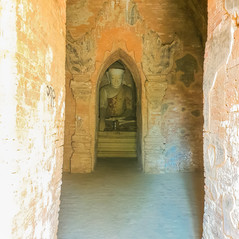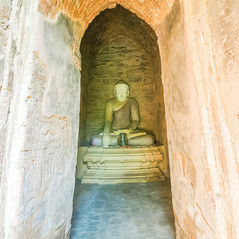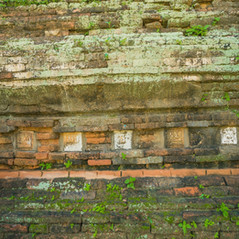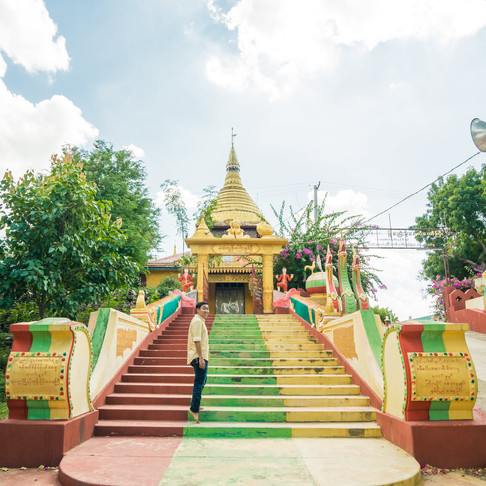Number of ancient heritages in Pinya was less than those of Inwa because some of these heritages were renovated but some had disappeared in public buildings and crop lands. Most of the young people of Mandalay cannot immediately give directions for routes to locations of significant sites in ancient Pinya city or places around TadaU. I set a target of my article for travellers who are willing to pay visits to Pinya in addition to Mandalay and Inwa.

Past events of Pinya era
Pinya and Sagaing city states flourished contemporary with late Bagan before establishment of Inwa city state. Pinya was contemporary with Bagan before the state of latter’s ruin. In Bagan era, Pyaw Shan national Theinkhabo who came from Myinsaing region to Bagan entrusted his three sons to King Narathihapatae. King Kyawswa, son of King Narathihapatae, of Bagan honoured eldest Athinkhaya to govern Myinsaing city, younger Yazathingyan to Makkhaya city and youngest Thihathu to Pinle city. At a time when younger Yazathingyan passed away, youngest Thihathu assassinated the eldest with poison so as to occupy property of two elder brothers. He moved his residence to Inwa and then built Pinya city for four times but missions failed. So, he established Pinya city again near Panlaung River, five miles south of Inwa on 9 February 1313 AD. Now, Pinya city state is more than 700 years old. At that time, Pinya and Sagaing were ruled by contemporary kings.
How to visit Pinya city
Ancient Pinya city state is located on western bank of Panlaung River between Mandalay-Myingyan railroad and Sakar-in Village, one mile south of TadaU. So you should say to the guides you wish to visit around Sakar-in Village of TadaU.
Travelling sites in ancient Pinya city

Everything is not significant in Pinya. Some red posts as ancient heritages can be seen here and there. Specifically, I on my trip to ancient Pinya city felt experiences of visiting an Anyar village with a far distance from Mandalay on arrival at Sakar-in Village. It was because the village was filled with simplicities as well as traditional activities at the Buddha Pujaniya festival.
Shwezigon Pagoda in Pinya

King Thihathu built Pinya Shwezigon Pagoda. I saw some red posts mentioning that there was an ancient region. I knew the pagoda was enshrined with five of seven sacred relics of the Lord Buddha in the reign of King Anawrahta. The original pagoda built by King Thihathu was enveloped by his son King Uzzana. Such a move showed a tradition of Pinya era when locals hoisted umbrellas atop the pagoda. It was because the original pagoda was seen with umbrella in a good condition when the enveloped pagoda collapsed in bad weather.
Three great caves in Pinya

The main aim on my trip to Pinya was to visit three great caves located in west of TadaU-Kyaukse road but these caves meant caves for Buddha images. Anyone does not exactly know who built these caves but locals said the southern cave was built by King Thihathu. Works of images were in mostly similar to those of Bagan. These were double caves. The stone plaques found in the cave mentioned that King Uzzana donated land plots for three great caves.
These great caves were massive and similar to each other. Caves were located 120 feet in distance to each other and they stretched from the south to the north, and the middle one was the largest. Two caves on the wings were facilitated with ladders to the caves but the warnings were posted not to climb the caves. The caves were built with four arches, each of which had a Buddha image. With regard to mural paintings, I did not have any evidences. There remain some glazed terracotta plaques at the caves. But I could not guess the images of terracotta plaques. In fact, such scene was good to take photos.

Royal palace site in Pinya

I faced difficulties to search the royal palace site. I asked the village administer at his residence for location of the royal palace site. Thanks to him, I found the royal palace site after walking along a furlong route beside a dragon fruit farm, north of three great caves. Firstly, I found a mound of a collapsed pagoda. Then, I saw a post bearing a directive to the royal palace site. The archaeologist team recorded an inscription on the post, mentioning that the two-month excavation was conducted at the royal palace site in 1994. It was reported that the royal palace area was on more than 120,000 square feet of land. Many buildings of the royal palace were connected with Samok building and Sanu building in accord with the tradition of ancient Myanmar kings. That was why the royal palace might be formed with more than 10 buildings but all the buildings were burnt down.
NanU Pagoda

Later, I knew a collapsed pagoda beside the post of royal palace site was NanU Pagoda. Today, the original architectural works of NanU Pagoda was not guessable.
Yadana Myasigon Pagoda

There were two same titles of Yadana Myasigon Pagoda in Pinya. One of two was Pyinsamaleinda Yadana Myasigon Pagoda but I could not find it. I asked locals for the route to another Yadana Myasigon Pagoda. I thought the pagoda was built of pieces of shale stones because I noticed sand at damaged parts. The ladder leading to the monastery at the entrance to the pagoda caught my attention to take photos.
Yanaungmyin Pagoda

It is located in Themaungkan Village of TadaU. I thought the pagoda was included in area of Pinya because it might be built in Pinya era. I went to the pagoda from the road leading to the international airport to the expressway. Inwa King Minkhaung built Sikhongyi in Yanaungmyin area and ordered all to call the pagoda as Yanaungmyin Sikhongyi. Some evidences mentioned the pagoda was built by King Anawrahta and renovated by King Minkhaung.
Aungsikhon Pagoda in Pinya
Aungsikhon Pagoda was constructed by King Swa Saw Ke. As the pagoda is located near Sakar-in Village, travellers can pay visit to the pagoda after wondering around Sakar-in Village. Scenes I saw from a terrace of the pagoda were very beautiful. There remain some glazed terracotta plaques at the pagoda.
Sakar-in Village

Whoever pays visit to Pinya, they must pass through Sakar-in Village. So they should pay visit to the village without fail. I myself observed traditional culture of the village while eating fried snacks near the lake in centre of the village. Local people use bullock-carts for transportation till today. I liked simple nature of the village even though it is close to Mandalay.
Maha Mingala Pagoda

It was reported that Maha Mingala Pagoda which positioned in TadaU is central between Pinya and Inwa royal palaces. The pagoda was built by King Minkhaung II in 842 Myanmar era when he came to the throne. The interior of pagoda is filled with ancient paintings and sculptural works. The paintings illustrated by Abbot U Acinna of Kyauksataing Monastery and the Jataka stories depicted with reliefs are very interesting.
Although there are travelling sites in Pinya less than those of Inwa, the former is an attractive destination for travellers. Based on that region, authorities should strive for more improvement of tourism services. Collapsed and damaged stupas and temples in the region show a style of Myanmar’s dry regions. It is sure that if tourist destinations and domestic industries can be exposed in nearby villages, Pinya will have attractiveness to local travellers and globetrotters.

I wish may all have a nice, safe and sound trip in health and happiness.
Thiha Lu Lin (Thiha, the Traveller)
Photo :: Thiha Lu Lin, Phyo Wana Aung
Camera :: SONY Alpha 7II with 16 - 35mm Lens
Photos are modified in Lightroom by Thiha Lu Lin
Translated by Than Tun Aung
-03.png)




























































Comments